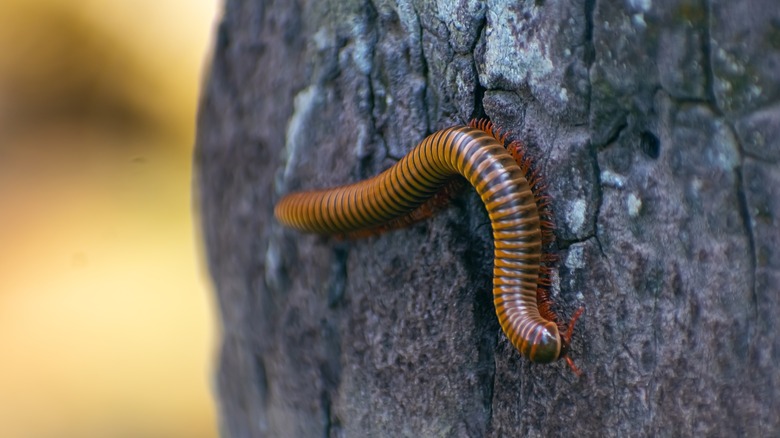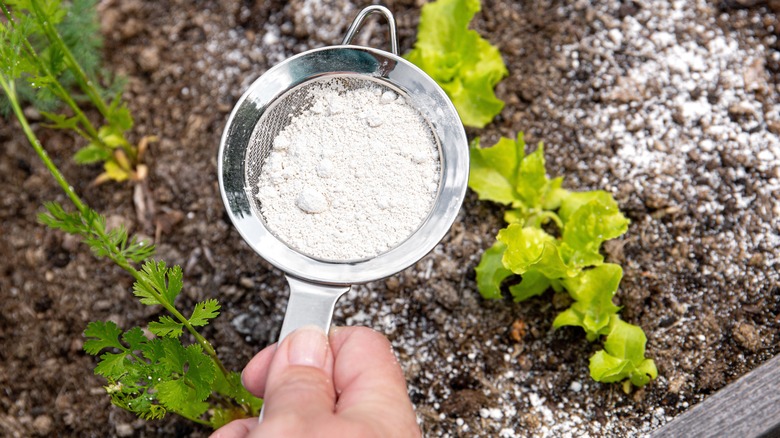Banish Millipedes From Your Home With These Household Staples
We may receive a commission on purchases made from links.
If you've ever come face to face with a millipede in your home, you likely don't need any explanation for why removing them can feel like a must. Commonly confused for their venomous cousin — the centipede — millipedes are relatively harmless arthropods. They don't bite or sting, and they aren't venomous. Some do excrete a mildly toxic substance containing hydrochloric acid that can cause an unpleasant odor to surround them and result in skin and mucus membrane irritation for humans who handle them.
Regardless of their technically harmless nature, however, millipedes are downright creepy in appearance. They resemble large earthworms, but with hundreds of tiny legs and a prominent pair of antennae. Some even glow in the dark! It goes without saying that most people who discover millipedes in their homes want them gone as soon as possible. Fortunately, since they pose no real risk of harm, millipedes can be repelled using simple staples found in nearly every house, garage, or garden shed.
Trap and relocate
The most humane way to rid your home or garden of millipedes is to trap the arthropods and simply move them to an area that is more appropriate for them to live in. Millipedes prefer very damp surroundings — preferably on or under decaying organic matter like fallen leaves or rotting wood. They are not at all suited for living inside the average home. Unless your home has major moisture issues, any millipede that makes its way inside will probably die shortly afterward.
Relocating these lost souls is as beneficial to them as it is to you. Stomping on them will only release more of their foul-smelling, corrosive defense mechanism inside your home. Since you don't want this substance coming into contact with your skin or eyes, live traps are the ideal way to move these creatures. Simply place a piece of fruit inside an empty water or soda bottle. Lay the bottle on the floor on its side and insert a tube or straw that's wide enough for a millipede to fit through. The creepy crawlies will find their way into the bottle for food but won't be able to find their way back through the tube to get out. To release the millipedes, take the bottle outside and lay it in a moist, dark area. Remove the tube or straw to allow them to crawl back out and be free.
Tea tree or peppermint oil
If getting up close and personal to relocate the millipedes in your home sounds like something from a horror movie to you, we understand. Luckily, there are other easy and humane ways to repel these pests. The right essential oils seem to irritate millipedes and cause them to avoid a particular area. The strong scents of tea tree and peppermint oils, in particular, are believed to work well to keep millipedes away. Since both of these oils are known for their medicinal properties, they are likely to be found in many homes' medicine cabinets.
Just dilute your oils using water or carrier oil and spray or drip the mixture around the areas where you suspect millipedes are entering your home. Apply the oils to the interior and exterior of the entryways. However, keep in mind that both tea tree and peppermint oils are considered toxic to pets in high concentrations. If the areas inside your home being visited by millipedes are also often frequented by your pets, this may not be the best repellent method for you. While there's no science-backed proof that essential oils are effective at repelling millipedes, it's a solution that exterminators suggest.
Cayenne pepper
What if the answer to your millipede problem was hiding in plain sight inside your kitchen cabinet in the form of a common spice? In reality, that could very well be the case. Spicy smells like cayenne pepper could repel millipedes in the same way strong-smelling essential oils do. Not a spicy food fan yourself? You can purchase a relatively giant canister of cayenne pepper just for repelling millipedes (and other pests) for less than $10 on Amazon.
Simply sprinkle the pepper around the inner perimeter of your home, using a slightly heavier hand around entryways and areas where moisture tends to accumulate. While there's no scientific backing for this solution, some pest control companies often tout it. Cayenne pepper is non-toxic, but it can be dangerous for pets and small children to ingest or handle, thanks to its spicy nature. Touching the pepper and then rubbing your eyes, for instance, can result in both skin and eye irritation in the form of burning and redness. While this discomfort should be temporary and resolved with washing, it may be best to skip the pepper if you live with pets or young children.
Neem oil
If you happen to garden or keep indoor houseplants, you likely have some neem oil on hand as a natural insecticide for instances of pesky mite or aphid infestations. What you might not know is this common garden shed staple can also be used in your home to repel millipedes on or off your plants. Unlike most natural methods for removing these unsightly pests from your home, neem oil does more than just deter — it kills.
For those who are looking for humane ways to remove millipedes from their home, neem oil isn't the ideal option. Instead of acting as a poison, neem oil disrupts an insect's brain and body's ability to send and receive hunger signals. Once a millipede is exposed to neem oil, it will lose its desire to feed, eventually starving to death. To use neem oil for millipede removal, mix about ¾ cup of the oil with about a teaspoon of dish soap and a liter of warm water in a spray bottle. Spray the mixture liberally on houseplants and around entryways. Neem oil is safe for both pets and edible plants.
Diatomaceous earth
Some gardeners prefer to use diatomaceous earth as a natural insecticide instead of — or in conjunction with — neem oil. Diatomaceous earth is another common lawn and garden staple that can be put to work to rid your home of unwanted millipedes. Much like neem oil, diatomaceous earth is not a humane means of getting rid of millipedes. Due to its abrasive nature, this natural silica powder causes many tiny cuts on millipedes' exoskeletons on contact. This exposes the arthropods' vulnerable insides and dries them out to the point of death.
While diatomaceous earth isn't considered poisonous, it is a major skin, eye, and lung irritant. Gloves and a mask are required to safely apply the substance to the outside perimeter and entryways of your home. It should not be applied to your home's interior, especially if you have pets or small children. Once you have spread diatomaceous earth, avoid the area for at least an hour before revisiting it in order to allow the dust to fully settle and prevent skin, eye, or lung exposure.
Salt
Millipedes require a high-moisture environment to survive. Because of this need for dampness, pest control experts believe these pests are not fans of salt. Salt is able to draw out moisture and has a drying effect on its surroundings, which is not a good fate for a millipede. This is true for salts of all kinds, including table, sea, and rock salt. Unlike lethal methods of millipede removal, such as neem oil or diatomaceous earth, salt can sometimes keep millipedes away without killing or harming them.
To use salt for keeping millipedes at bay, simply sprinkle it liberally around your home's perimeters, its entryways, and in areas where you suspect moisture has been accumulating. Look for dark corners in the bathroom, kitchen, and anywhere else exposed to a water source. You may wish to combine a method like salt with trapping and relocating in order to remove the millipedes that are already present and prevent new ones from entering at the same time.
Vinegar
When it comes to scent, millipedes are quite picky customers. Along with smelly essential oils like tea tree and peppermint and spicy cayenne pepper, these many-legged horrors can't stand the corrosive smell of acidic vinegar. Any area of your home that comes into contact with vinegar and the acetic acid it contains will soon be rid of this particular pest. Keep millipedes out of your house by filling up a spray bottle with white vinegar. If you don't already keep this staple around your kitchen, you can snag a 32-ounce bottle on Amazon for about $2.
Simply spray the vinegar wherever you suspect that millipedes are entering your home or existing within it. Pay special attention to entryways and areas where darkness and dampness collide. If you happen to spot any millipedes while you're treating your home with vinegar, don't be afraid to spray them directly. While the vinegar is not likely to kill the millipedes, it will irritate them — prompting them to pack their proverbial bags and scramble to the nearest exit.







